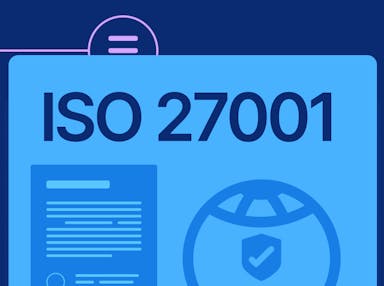
10 Popular Risk Management Frameworks & How to Choose Between Them
Emily Bonnie
Senior Content Marketing Manager
Rob Gutierrez
Senior Cybersecurity and Compliance Manager, CISA, CCSK, CMMC RP
Only 33% of U.S. companies have enterprise risk management processes in place, and just 29% rate their risk management strategy as "mature" or "robust." Most companies are navigating risk without a clear strategy, leaving them vulnerable to unexpected disruptions.
Companies need an organized, methodical approach to identifying and assessing risks, but figuring out exactly what steps to take can be confusing.
The good news is that several risk management frameworks have been developed by expert organizations to help give companies a clear method for building stronger, more effective risk management programs. Below, we’ll provide an overview of each framework and offer tips to help you decide which approach might be the best fit for your needs.
What is a risk management framework?
A risk management framework helps organizations identify, assess, and manage business risks. Think of it as an organized approach to spotting threats and vulnerabilities, figuring out how serious they are, deciding how to handle them, and tracking them over time.
Using a framework also ensures you’re not overlooking any major risks. It helps make sure your risk assessments are thorough, your mitigation efforts are focused on what matters most, and you're continuously monitoring for new threats.
Most importantly, it helps you better understand your specific risk landscape and address all types of risks that could affect your business, including:
- Operational risk: Risks that come from internal processes, systems, or people.
- Strategic risk: Risks that impact your ability to meet business goals.
- Cyber risk: Risks from data breaches, cyberattacks, and IT vulnerabilities.
- Supply chain risk: Risks that arise when third-party partners fail to deliver.
- Regulatory and compliance risk: Risks of failing to meet legal or regulatory requirements.
- Financial risk: Risks related to cash flow, investments, and financial markets.
- Reputational risk: Risks that could harm how customers, partners, or the public view your business.
- Geopolitical risk: Risks arising from political events, instability, or changes in government policies that can impact business operations, supply chains, or market access.

Next, let’s explore some of the most recognized risk management frameworks and how they can help you protect your business.
The NIST Risk Management Framework (NIST RMF)
The NIST Risk Management Framework (RMF) is a comprehensive, flexible, and repeatable process developed by the National Institute of Standards and Technology (NIST). It’s designed to integrate security and risk management into every phase of an organization’s system development lifecycle.
The RMF ensures that security and privacy aren’t afterthoughts, but are woven into the fabric of how systems are developed, operated, and maintained. It's about making risk management an ongoing, methodical process that aligns with an organization's broader mission and business objectives.
The framework consists of seven steps.
- Prepare: Involves understanding the organization’s risk context, defining risk tolerance, and identifying the resources needed for effective risk management.
- Categorize: Involves classifying information systems based on the potential impact a security breach could have on operations, assets, or individuals.
- Select: Organizations choose security controls tailored to the risk levels identified during categorization.
- Implement: Controls are deployed within the system and thoroughly documented.
- Assess: Ensures the controls are functioning as intended and effectively reducing risk.
- Authorize: Requires decision-makers to evaluate the overall risk and determine if the system should be approved for operation.
- Monitor: Involves ongoing assessment and adjustment of security controls to ensure they remain effective over time.
Use the NIST RMF if you need a structured, detailed approach to managing security and privacy risks, especially for systems that process sensitive data. It's mandatory for U.S. federal agencies but is also a strong choice for state, local, and tribal governments, as well as private sector organizations that want to align with federal standards or manage high-risk environments. The RMF is particularly useful if you want a repeatable, lifecycle-based process to integrate security and privacy into every phase of your system development and operations.
Recommended reading

Understanding the NIST Risk Management Framework: A Comprehensive Guide
The COSO Enterprise Risk Management Framework (ERM)
The COSO ERM Framework, developed by the Committee of Sponsoring Organizations of the Treadway Commission (COSO), is all about integrating risk management with your organization's strategy and performance. It's designed to help companies identify, assess, and manage risks that could impact their ability to achieve strategic objectives.
The framework is structured around five core components:
- Governance and Culture establishes the organizational foundation for risk awareness and accountability.
- Strategy and Objective-Setting ensures that risk considerations are integrated into business planning and that objectives align with the organization’s risk appetite.
- Performance involves identifying, assessing, and managing risks that could impact the achievement of objectives.
- Review and Revision emphasizes the importance of ongoing evaluation and improvement of risk management practices.
- Information, Communication, and Reporting ensures that relevant risk information is communicated effectively within the organization and to stakeholders.
Use the COSO ERM if you're looking for a broad, strategic approach that's applicable across all aspects of your business, from cybersecurity to financial risk. It's particularly useful if you want to align risk management directly with your business goals and decision-making processes.
ISO 31000
ISO 31000 is an international standard for risk management, providing guidelines that can be applied to any organization, regardless of size or industry. It is designed to be adaptable and scalable, providing flexibility while ensuring that risk management remains structured and consistent, with a special focus on continuous improvement.
The ISO 31000 process involves several key principles:
- Integration ensures risk management is part of organizational decision-making at every level.
- Customization allows organizations to tailor the framework based on their specific risk profile and operational context.
- Structured and Comprehensive processes ensure a consistent and thorough approach.
- Dynamic principles recognize that risks evolve and require responsive management.
- Inclusivity encourages engaging stakeholders in the risk identification and management process.
If you're looking for a flexible, all-purpose framework that can apply to any type of risk, ISO 31000 is a great choice. It's especially useful for organizations that value adaptability and need a framework that can evolve with their business.
Recommended reading

Cyber Risk Quantification: How It Can Help Protect Your Digital Assets
COBIT
COBIT (Control Objectives for Information and Related Technologies) is an IT governance and management framework developed by ISACA. It is designed to help organizations align their IT objectives with broader business goals while ensuring that IT risks are effectively managed.
The framework is based on five core principles:
- Meeting Stakeholder Needs ensures that IT initiatives align with business objectives and stakeholder expectations.
- Covering the Enterprise End-to-End integrates IT governance with overall organizational governance, ensuring that IT is considered in strategic decision-making.
- Applying a Single Integrated Framework provides a consistent approach to IT management and governance, leveraging industry standards and best practices.
- Enabling a Holistic Approach encourages consideration of all governance enablers, including processes, organizational structures, and cultural aspects.
- Separating Governance from Management clarifies the roles of governance (evaluating and directing) versus management (planning and execution).
COBIT also provides a detailed process model with management and governance objectives, performance metrics, and risk mitigation strategies.
Use COBIT if your organization has complex IT systems and you're looking for a structured approach to IT governance. It's especially valuable for industries where data integrity and IT risk management are critical, such as finance, healthcare, and government.
The NIST Cybersecurity Framework 2.0 (NIST CSF)
The NIST CSF 2.0 is designed to help organizations manage and reduce cybersecurity risks. It provides a flexible, risk-based approach and is widely used across industries.
The framework consists of six core functions that represent the lifecycle of an effective cybersecurity program:
- Govern: Establishes and monitors the organization's cybersecurity risk management strategy, expectations, and policies. This function underscores the role of governance in aligning cybersecurity efforts with business objectives.
- Identify: Develops an understanding of the organization's cybersecurity risks, including assets, data, and potential threats. This step helps prioritize cybersecurity efforts.
- Protect: Focuses on implementing safeguards to ensure the delivery of critical services, such as access control, data security, and awareness training.
- Detect: Outlines processes to identify cybersecurity incidents in a timely manner.
- Respond: Provides guidance on developing and implementing response strategies to mitigate the impact of cybersecurity incidents.
- Recover: Ensures that organizations have plans in place to restore services and capabilities following an incident.
Each function is supported by categories and subcategories that provide additional guidance on achieving specific cybersecurity outcomes.
If you're looking to strengthen your cybersecurity posture with a practical, adaptable framework, the NIST CSF 2.0 is an excellent choice. It's widely used by organizations in critical infrastructure sectors but is also suitable for businesses of all sizes aiming to enhance their cybersecurity defenses.
Recommended reading

The NIST Cybersecurity Framework 2.0: What Is It & How to Comply [+ Checklist]
Center for Internet Security Controls (CIS)
The CIS Controls are a set of prioritized and actionable best practices developed by the Center for Internet Security. They are designed to help organizations defend against the most common and pervasive cybersecurity threats. What makes the CIS Controls unique is their focus on simplicity and effectiveness—offering a straightforward path to building a solid cybersecurity foundation.
The framework consists of 18 controls that cover essential areas like asset management, data protection, access control, incident response, and continuous monitoring. These controls are structured in three implementation groups (IG1, IG2, and IG3), allowing organizations to adopt controls based on their size, complexity, and risk exposure.
- IG1 is designed for smaller organizations or those with limited cybersecurity expertise.
- IG2 is suitable for organizations with moderate risk profiles and more advanced cybersecurity programs.
- IG3 is intended for organizations facing sophisticated threats, such as those in critical infrastructure sectors.
Use CIS controls if you’re looking for a practical, easy-to-follow framework that focuses on the highest-impact cybersecurity practices. They’re ideal for organizations that need to strengthen security quickly or who are new to formal risk management.
FAIR (Factor Analysis of Information Risk)
The FAIR (Factor Analysis of Information Risk) framework is a quantitative risk management model that helps organizations measure and analyze cybersecurity risks in financial terms. Developed by the FAIR Institute, this framework offers a structured approach to understanding how likely a cybersecurity event is and what its potential financial impact could be.
Unlike other frameworks that focus on qualitative risk assessments, FAIR helps organizations assign monetary values to risks, making it easier to prioritize security investments and communicate risks to executives and stakeholders.
FAIR’s process involves:
- Identifying Assets and Threats: Understanding what needs to be protected and who or what poses a threat.
- Measuring Frequency and Impact: Estimating how often a threat is likely to occur and what the potential consequences could be.
- Analyzing Risk Scenarios: Evaluating different scenarios to determine the level of risk.
- Calculating Financial Impact: Using data to estimate the potential financial loss from a security incident.
If you need to justify security investments or clearly communicate risk to executive leadership, FAIR is an ideal framework. It's especially valuable for organizations with complex risk environments that require a data-driven, financial perspective to inform risk decisions.
ISO 27001
ISO 27001 is an international standard that provides a framework for establishing, implementing, maintaining, and improving an Information Security Management System (ISMS). It helps organizations manage sensitive information securely and systematically.
The framework emphasizes the importance of conducting thorough risk assessments to identify information security risks and implementing appropriate controls to mitigate them. Leadership commitment is critical, ensuring that senior management is involved in setting security objectives and driving the program forward. ISO 27001 requires organizations to develop detailed security policies and procedures that define how information security is managed. Continuous improvement is a core principle, requiring regular monitoring and reviews to adapt to evolving threats and vulnerabilities.
ISO 27001 is ideal if you're looking to demonstrate your commitment to information security, especially if you manage sensitive data or are subject to industry regulations. It's particularly beneficial for organizations that need to prove compliance to partners, regulators, and customers.
Recommended reading

The ISO 27001 Compliance Hub
The RIMS Risk Maturity Model (RMM)
The RIMS RMM is designed to help organizations assess and enhance the maturity of their risk management practices. It provides a detailed framework for evaluating and improving risk management capabilities.
The model covers seven attributes:
- An ERM-Based Approach ensures that risk management is integrated into strategic decision-making and core business processes.
- ERM Process Management evaluates the structure and repeatability of risk management processes.
- Risk Appetite Management focuses on defining and communicating the organization’s risk tolerance.
- Root Cause Discipline encourages organizations to analyze the underlying causes of risks for better prevention.
- Uncovering Risks evaluates the organization’s ability to proactively identify potential risks.
- Performance Management ensures that risk management is aligned with business performance objectives.
- Business Resiliency and Sustainability looks at the organization’s ability to maintain operations during disruptive events.
If you're looking to benchmark your current risk management practices and develop a roadmap for continuous improvement, RIMS RMM is a valuable tool. It's useful for organizations aiming to elevate their risk maturity and align their processes with industry standards.
NIST Artificial Intelligence Risk Management Framework (AI RMF)
The NIST AI Risk Management Framework (AI RMF) was developed by the National Institute of Standards and Technology (NIST) to help organizations identify, assess, and mitigate risks associated with artificial intelligence (AI) systems. As AI adoption continues to grow across industries, concerns about bias, security, transparency, and reliability have become critical. The AI RMF provides a structured approach to managing these risks and ensuring AI systems are designed, deployed, and used responsibly.
The framework is built around four key functions:
- Govern: Establishes AI risk management as an ongoing organizational priority. This involves creating policies, assigning responsibilities, and fostering a culture that promotes trustworthy AI development and use.
- Map: Focuses on understanding the context of an AI system, including its intended purpose, capabilities, limitations, and potential risks.
- Measure: Involves assessing AI risks through testing, monitoring, and evaluating AI system performance to ensure it meets ethical and security standards.
- Manage: Guides organizations in responding to AI risks by implementing controls, adjusting processes, and continuously improving AI governance.
If your organization develops, deploys, or uses AI systems, this framework is essential for ensuring those systems operate ethically, securely, and transparently. It’s particularly valuable for businesses in highly regulated industries, such as healthcare, finance, government, and critical infrastructure, where AI systems must comply with strict security, privacy, and fairness requirements.
Recommended reading

Understanding the NIST AI RMF: What It Is and How to Put It Into Practice
How to decide which risk management framework to use
Choosing the right risk management framework depends on your specific organizational goals, industry requirements, and the types of risks you want to manage. Here are some guiding questions to consider:
- What are your primary risks?
If your focus is on cybersecurity, frameworks like NIST CSF, ISO 27001, or CIS Controls may be the best fit. For broader enterprise risks, COSO ERM or ISO 31000 could be more appropriate. If you're developing or deploying artificial intelligence systems, the NIST AI RMF can help you identify and mitigate risks like bias, security vulnerabilities, and ethical concerns. - Are there industry regulations to consider?
Frameworks like NIST RMF or COBIT are often required for organizations handling federal data or managing IT risks. Similarly, if you're working with AI in regulated industries like healthcare, finance, or government, adopting the NIST AI RMF can help you stay aligned with emerging standards and regulations. - What is your organization’s size and complexity?
Larger organizations may benefit from the structured processes of ISO frameworks, while smaller businesses might prefer the flexibility and scalability of frameworks like NIST CSF or CIS Controls. For AI-focused companies or tech startups, the NIST AI RMF provides adaptable guidelines for managing AI risks without excessive complexity. - Do you need to quantify risks?
If you're looking to analyze cybersecurity risks in financial terms and clearly communicate them to leadership, the FAIR framework is an excellent choice. - How mature is your risk management program?
The RIMS RMM can help assess your current risk management maturity and identify areas for improvement. If you're early in your AI journey, the NIST AI RMF offers a practical starting point for building responsible AI practices.
Creating a simple pros and cons list for each framework or mapping them against your main business objectives can help guide your decision. Consulting with a risk management professional or conducting a gap assessment may also provide valuable insights.
Using GRC automation to enhance risk management
Governance, Risk, and Compliance (GRC) platforms can streamline and enhance risk management efforts by automating key processes. These platforms can:
- Automate risk assessments: Quickly identify and assess risks using pre-built templates and automated workflows.
- Generate risk treatment suggestions: Provide recommended mitigation strategies and calculate residual risk levels.
- Third-party risk monitoring: Track vendor risks and manage compliance vendor and risk requirements against frameworks such as CIS, NIST AI RMF, NIST CSF, and many more.
- Maintain risk registers and libraries: Keep an organized record of risks, controls, and mitigation efforts for easy tracking and reporting.
By using a GRC platform, organizations can save time, improve accuracy, and ensure that risk management processes are continuously updated and aligned with evolving business needs and aligned compliance requirements.
Use trust to accelerate growth

Emily Bonnie
Senior Content Marketing Manager
Emily Bonnie is a seasoned digital marketing strategist with over ten years of experience creating content that attracts, engages, and converts for leading SaaS companies. At Secureframe, she helps demystify complex governance, risk, and compliance (GRC) topics, turning technical frameworks and regulations into accessible, actionable guidance. Her work aims to empower organizations of all sizes to strengthen their security posture, streamline compliance, and build lasting trust with customers.

Rob Gutierrez
Senior Cybersecurity and Compliance Manager, CISA, CCSK, CMMC RP
Rob Gutierrez is an information security leader with nearly a decade of experience in GRC, IT audit, cybersecurity, FedRAMP, cloud, and supply chain assessments. As a former auditor and security consultant, Rob performed and managed CMMC, FedRAMP, FISMA, and other security and regulatory audits. At Secureframe, he’s helped hundreds of customers achieve compliance with federal and commercial frameworks, including NIST 800-171, NIST 800-53, FedRAMP, CMMC, SOC 2, and ISO 27001.